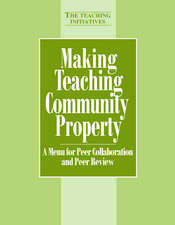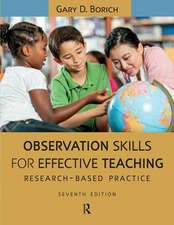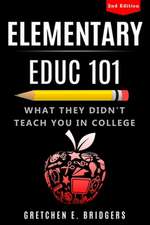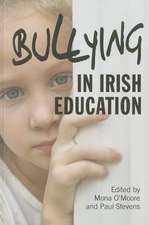Mindful Learning: 101 Proven Strategies for Student and Teacher Success
Autor Linda M. Campbell, Bruce Campbellen Limba Engleză Paperback – 22 oct 2008
A greater emphasis on teaching students in special populations
New strategies and graphics based on the most current brain-based research
Reorganized strategies to help readers find information easily.
| Toate formatele și edițiile | Preț | Express |
|---|---|---|
| Paperback (1) | 316.44 lei 6-8 săpt. | |
| SAGE Publications – 22 oct 2008 | 316.44 lei 6-8 săpt. | |
| Hardback (1) | 569.87 lei 6-8 săpt. | |
| SAGE Publications – 4 noi 2008 | 569.87 lei 6-8 săpt. |
Preț: 316.44 lei
Nou
Puncte Express: 475
Preț estimativ în valută:
60.55€ • 63.38$ • 50.40£
60.55€ • 63.38$ • 50.40£
Carte tipărită la comandă
Livrare economică 31 martie-14 aprilie
Preluare comenzi: 021 569.72.76
Specificații
ISBN-13: 9781412966931
ISBN-10: 1412966930
Pagini: 216
Dimensiuni: 216 x 279 x 15 mm
Greutate: 0.61 kg
Ediția:Second Edition
Editura: SAGE Publications
Colecția Corwin
Locul publicării:Thousand Oaks, United States
ISBN-10: 1412966930
Pagini: 216
Dimensiuni: 216 x 279 x 15 mm
Greutate: 0.61 kg
Ediția:Second Edition
Editura: SAGE Publications
Colecția Corwin
Locul publicării:Thousand Oaks, United States
Recenzii
"This book is a teacher’s toolbox, full of strategies that will strengthen student achievement. Once a teacher receives this resource, everyone in the school will want a copy!"
"Compiles what many teachers have discovered through years of trial and error into an easy-to-implement format. While some strategies are similar to those used by master teachers, others are refreshingly new."
"For teachers who want to use more research-based strategies but have little time, this book is a gem. The simple format, great diagrams, additional reading sources, and research-supported strategies are all time-savers for busy educators."
"Compiles what many teachers have discovered through years of trial and error into an easy-to-implement format. While some strategies are similar to those used by master teachers, others are refreshingly new."
"For teachers who want to use more research-based strategies but have little time, this book is a gem. The simple format, great diagrams, additional reading sources, and research-supported strategies are all time-savers for busy educators."
Cuprins
Preface to the Second Edition
Acknowledgments
About the Authors
Introduction
1. Beginning With What Students Know: The Role of Prior Knowledge in Learning
What Role Does Background Knowledge Play in Learning?
What Do Research Studies Show About Prior Knowledge?
#1: The Known and the Unknown
#2: Things I Know, Think I Know, Want to Know
#3: What I Know, Want to Know, and Learned
#4: Getting Organized Graphically
#5: Visual Sequencing
#6: Visualizing Cause and Effect
#7: Seeing Similarities and Differences
#8: The Whole Pie
#9: Speaking Categorically
#10: Commonly Shared Prior Experiences
#11: Charting a Colorful Course
#12: Asking the Right Questions
#13: Guided Anticipation
#14: Thinking Out Loud
#15: Using Prior Knowledge Before, During, and After a Lesson
#16: It’s About the Words
#17: Word Diagramming
#18: Tracking Progress With Words
#19: Math Dilemmas
Suggestions for Further Information About Prior Knowledge
2. Active Learning: Differentiated Strategies for All Learners
What Do Research Studies Show About Active Learning?
Active Learning in the Classroom
#20: Give Me Five! An Active Learning Wheel for Teachers and Students
#21: A Collaborative and Active Learning Sequence
#22: A Day of Active Division
#23: Visually Introducing a Unit
#24: Structured Concepts
#25: Visual Report Writing
#26: Charting Skills: Estimation
#27: Visual Story Mapping
#28: Mass Media’s Messages
#29: Active Listening
#30: Active Reading
#31: Textbooks Are Friends!
#32: Active Involvement Through Discussion
#33: It’s Notable
#34: Thinking From A to V
#35: That’s Debatable
#36: Jigsaw Cards and Puzzles
#37: I’m Game
#38: Musical Learning
#39: Narrative Pantomime
#40: Role-Playing to Learn
#41: A Week’s Worth of Journaling
#42: Student Goal Setting
#43: Project-Based Learning
#44: Pulling It Together: Class Books
Suggestions for Further Information About Active Learning
3. Ensuring Gender-Fair Instruction
What Do Research Studies Show About Gender-Equitable Approaches to Improving Student Achievement?
#45: Conducting a Classroom Gender Audit
#46: Seeking Student Feedback on Gender Dynamics
#47: Assessing Bias in Curricular Materials
#48: Quality Questioning
#49: Using Inclusive Language
#50: Thinking While Listening
#51: Mix and Match
#52: Playing Games
#53: Sequence Cards
#54: Paper Plate Review
#55: Headbands
#56: A Word Tool Kit
#57: Bite-Size Reading
#58: Teaching Boys to Write
#59: Six Tips for Tech-Savvy Girls
#60: Creating a “Boy-Friendly” Classroom
#61: Exploring New Roles at School
#62: Peer Support Networks
#63: Orienting Eighth and Ninth Graders to High School
#64: Middle School Academic Preparation for High School Success
#65: Gender Equity Bookmark
Suggestions for Further Information About Gender Equity
4. Teaching Diverse Students: Addressing Language, Class, Culture, and Ability Differences in the Classroom
The Diversity of the U.S. Educational System
The Diversity of K-12 Students in the United States
Defining Racial Diversity
Defining the Concept of Students With Disabilities
Defining Students in Poverty
Defining Limited English Proficient Students
Implications of Student Diversity for the Classroom
Teaching Students With Special Needs in Mainstream Classrooms
Integrating Limited English Proficient Students Into Mainstream Classrooms
Teaching Racially Diverse Students
Teaching Students in Poverty
Reflecting on Teaching in Diverse Classrooms
#66: Tiered Instruction
#67: Tiered Spelling
#68: Do They Get It? Assessing Student Understanding in Inclusive Classrooms
#69: Teaching Elementary Readers
#70: Helping Struggling Intermediate Readers
#71: Teaching Reading in the Content Areas
#72: Helping Struggling Adolescent Readers
#73: Using Tutors to Increase Reading Achievement
#74: An Extra Net: Using Web Sites to Support the Needs of Diverse Learners
#75: Engaging the Gifted
#76: Helping New and Incoming Students
#77: Meeting the Needs of Preliterate English Language Learner Students
#78: Using English Effectively With English Language Learners
#79: Geometric Collaboration
#80: Collaborative Note Taking
#81: Teaching Standard English in the Multicultural Classroom
#82: High-Performing Teachers of High-Poverty Students
#83: Reducing Prejudice by Increasing Critical Thinking
#84: Multicultural Math
#85: Multicultural Literature
Suggestions for Further Information About Teaching Diverse Students
5. Assessing Student Performance
Defining Assessment Terms
What Does the Research Say About Using Assessment to Improve Teaching and Learning?
The Power of Performance Assessment
Using Performance Assessment in the Classroom
#86: It's Not Business as Usual: Planning for Assessment
#87: Beginning With the End in Mind
#88: Taking Stock: Student Self-Assessment
#89: Collaborative-Assessment Conferences
#90: Test-Taking Matters
#91: Test-Taking Rules for Students
#92: Getting to Know You: Entry Interviews
#93: Saying Goodbye: Exit Interviews
#94: Taking Note With Anecdotal Records
#95: Making Rubrics
#96: Assessing Orally
#97: Observation Logs
#98: Checking Their Lists: Student Checklists
#99: Learning Logs
#100: Assessing Nontraditional Results
#101: Scheduling Assessment
Suggestions for Further Information About Assessing Student Performance
6. Some Concluding Thoughts
References
Index
Acknowledgments
About the Authors
Introduction
1. Beginning With What Students Know: The Role of Prior Knowledge in Learning
What Role Does Background Knowledge Play in Learning?
What Do Research Studies Show About Prior Knowledge?
#1: The Known and the Unknown
#2: Things I Know, Think I Know, Want to Know
#3: What I Know, Want to Know, and Learned
#4: Getting Organized Graphically
#5: Visual Sequencing
#6: Visualizing Cause and Effect
#7: Seeing Similarities and Differences
#8: The Whole Pie
#9: Speaking Categorically
#10: Commonly Shared Prior Experiences
#11: Charting a Colorful Course
#12: Asking the Right Questions
#13: Guided Anticipation
#14: Thinking Out Loud
#15: Using Prior Knowledge Before, During, and After a Lesson
#16: It’s About the Words
#17: Word Diagramming
#18: Tracking Progress With Words
#19: Math Dilemmas
Suggestions for Further Information About Prior Knowledge
2. Active Learning: Differentiated Strategies for All Learners
What Do Research Studies Show About Active Learning?
Active Learning in the Classroom
#20: Give Me Five! An Active Learning Wheel for Teachers and Students
#21: A Collaborative and Active Learning Sequence
#22: A Day of Active Division
#23: Visually Introducing a Unit
#24: Structured Concepts
#25: Visual Report Writing
#26: Charting Skills: Estimation
#27: Visual Story Mapping
#28: Mass Media’s Messages
#29: Active Listening
#30: Active Reading
#31: Textbooks Are Friends!
#32: Active Involvement Through Discussion
#33: It’s Notable
#34: Thinking From A to V
#35: That’s Debatable
#36: Jigsaw Cards and Puzzles
#37: I’m Game
#38: Musical Learning
#39: Narrative Pantomime
#40: Role-Playing to Learn
#41: A Week’s Worth of Journaling
#42: Student Goal Setting
#43: Project-Based Learning
#44: Pulling It Together: Class Books
Suggestions for Further Information About Active Learning
3. Ensuring Gender-Fair Instruction
What Do Research Studies Show About Gender-Equitable Approaches to Improving Student Achievement?
#45: Conducting a Classroom Gender Audit
#46: Seeking Student Feedback on Gender Dynamics
#47: Assessing Bias in Curricular Materials
#48: Quality Questioning
#49: Using Inclusive Language
#50: Thinking While Listening
#51: Mix and Match
#52: Playing Games
#53: Sequence Cards
#54: Paper Plate Review
#55: Headbands
#56: A Word Tool Kit
#57: Bite-Size Reading
#58: Teaching Boys to Write
#59: Six Tips for Tech-Savvy Girls
#60: Creating a “Boy-Friendly” Classroom
#61: Exploring New Roles at School
#62: Peer Support Networks
#63: Orienting Eighth and Ninth Graders to High School
#64: Middle School Academic Preparation for High School Success
#65: Gender Equity Bookmark
Suggestions for Further Information About Gender Equity
4. Teaching Diverse Students: Addressing Language, Class, Culture, and Ability Differences in the Classroom
The Diversity of the U.S. Educational System
The Diversity of K-12 Students in the United States
Defining Racial Diversity
Defining the Concept of Students With Disabilities
Defining Students in Poverty
Defining Limited English Proficient Students
Implications of Student Diversity for the Classroom
Teaching Students With Special Needs in Mainstream Classrooms
Integrating Limited English Proficient Students Into Mainstream Classrooms
Teaching Racially Diverse Students
Teaching Students in Poverty
Reflecting on Teaching in Diverse Classrooms
#66: Tiered Instruction
#67: Tiered Spelling
#68: Do They Get It? Assessing Student Understanding in Inclusive Classrooms
#69: Teaching Elementary Readers
#70: Helping Struggling Intermediate Readers
#71: Teaching Reading in the Content Areas
#72: Helping Struggling Adolescent Readers
#73: Using Tutors to Increase Reading Achievement
#74: An Extra Net: Using Web Sites to Support the Needs of Diverse Learners
#75: Engaging the Gifted
#76: Helping New and Incoming Students
#77: Meeting the Needs of Preliterate English Language Learner Students
#78: Using English Effectively With English Language Learners
#79: Geometric Collaboration
#80: Collaborative Note Taking
#81: Teaching Standard English in the Multicultural Classroom
#82: High-Performing Teachers of High-Poverty Students
#83: Reducing Prejudice by Increasing Critical Thinking
#84: Multicultural Math
#85: Multicultural Literature
Suggestions for Further Information About Teaching Diverse Students
5. Assessing Student Performance
Defining Assessment Terms
What Does the Research Say About Using Assessment to Improve Teaching and Learning?
The Power of Performance Assessment
Using Performance Assessment in the Classroom
#86: It's Not Business as Usual: Planning for Assessment
#87: Beginning With the End in Mind
#88: Taking Stock: Student Self-Assessment
#89: Collaborative-Assessment Conferences
#90: Test-Taking Matters
#91: Test-Taking Rules for Students
#92: Getting to Know You: Entry Interviews
#93: Saying Goodbye: Exit Interviews
#94: Taking Note With Anecdotal Records
#95: Making Rubrics
#96: Assessing Orally
#97: Observation Logs
#98: Checking Their Lists: Student Checklists
#99: Learning Logs
#100: Assessing Nontraditional Results
#101: Scheduling Assessment
Suggestions for Further Information About Assessing Student Performance
6. Some Concluding Thoughts
References
Index
Notă biografică
Linda Campbell has extensive experience at all levels of education, including as a former public school K-12 teacher and NEA school restructuring specialist, and currently as a professor of education at Antioch University Seattle. In addition to serving as the University¿s project director for the Gates Foundation Early College Initiative for Native Youth, she is a consultant and a presenter. She also works with schools to promote the retention and achievement of Native American youth.
Descriere
With new forms, techniques, and checklists, this second edition provides 101 strategies for using learners' prior knowledge, differentiating instruction for diverse learning needs, and providing gender-fair instruction.



















